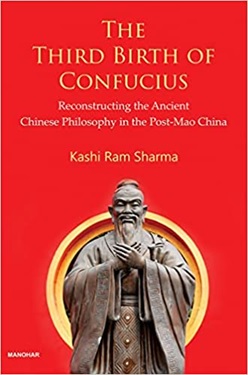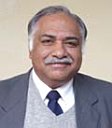Kashi Ram Sharma, ‘The Third Birth of Confucius: Reconstructing the Ancient Chinese Philosophy in the Post-Mao China’. New Delhi, Manohar, 2022. 385pp. Rs. 1,995.00Confucius has made a remarkable comeback in China. As the author emphasizes, “Confucius and Confucianism is in the blood of every Chinese. It is their DNA.”So the book by a renowned Indian Sinologist with long experience and expertise in the field of Chinese studies, and who has relied on Chinese and other primary sources, on the Chinese sage and philosopher Confucius and his legacies, is very timely and valuable. This insightful analysis of the Confucian thought and legacy combined with his critical commentary on the political processes within China is a very important tool to unravel “the muddled reality of China”.
While explaining the three births of Confucius, Prof. Sharma states that it was during the Han dynasty that Confucius and Confucianism became the ‘big’ philosophical and cultural tradition of China. This was the ‘First Birth of Confucius’, as China accepted him as the Philosopher of Philosophers. However, after the arrival of Buddhism in China in first century AD and particularly its glorious days during the Tang dynasty (618-907 AD), Chinese culture, philosophy, education, art, architecture, language, literature, poetry were impacted by Buddhism, which ‘overpowered’ Confucianism. But with the decline of Buddhism in eighth century AD, Confucianism started re-emerging. And by the twelfth century, Confucius was reborn, which the author describes as his ‘second birth’. Several Confucian thinkers mainly Han Yu, Cheng Yi, Cheng Hao and Zhu Shi caused the second birth of Confucianism in China. But, the advent of Western knowledge of science, technology, mathematics, medicine, engineering and modern education brought in by Christian missionaries from Europe from sixteenth century onwards, dented Confucianism in China. Finally, the “Western ideas of science, democracy and socialism shattered China’s faith in Confucius and Confucianism.” The author offers constructive critique of Western Sinologists like Jospeh Needham and others, who have drawn analogies between Confucius and Western thinkers like Aristotle, St. Thomas, Herbert Spencer etc. He rightly points to the ancient Indian philosophical thought and tradition of Vedas, Upanishads, Bhagwad Gita, Buddha’s teachings, Adi Shankracharya’s Advaita, which makes a strong case for cultural collaboration between the two ancient civilizations-India and China. At the same time, Indian academia and public circles need to delve deeper into China’s narratives and its process of cultural nationalism. Confucian concepts of harmony, governance by virtue and morals, meritocracy, ideal man, family, society and state, find a resonance in ancient Indian philosophy and narratives.
With Chinese Communist rule starting in 1949 and the primacy given to Marxist thought, Confucius was relegated to the background. But in 2000 AD, Confucius started taking rebirth, as the post-Marxist and post-Mao China wanted to recall Confucius to fill the ideological vacuum and to provide cover to the Chinese state, government and the party. Along with its fast modernization, China is reinventing Confucius to give enough space to its culture and civilization and as a symbol of its cultural nationalism. And this is described by the author as the Third Birth of Confucius. In its third birth, Confucianism in China is emerging both at official and people’s levels. According to Prof. Sharma, People’s Confucius is emerging faster than Official Confucius. About 20 million Confucius temples and statues have been built across China during the past twenty years. Courses on Confucius are offered in all colleges and universities. Besides, thousands of private academies teach Confucius to children.
First chapter gives details about the personal life of Confucius and his environs and basic tenets of his philosophy. Confucius (551-479 BC) lived and worked in turbulent times, with a number of feudal principalities conspiring and fighting among themselves, which led to Confucius’ search for an ideal society and ideal state. According to Prof. Sharma, “politically Confucius’s time was tumultuous but philosophically, it became the golden period of China”. So much so, the Chinese call this period (551-233 BC) as the period of ‘Hundred Schools’ of philosophy, prominent being Confucianism, Daoism, Mohism, Legalism, Yin and Yang, School of Five Material Elements. However, Confucius overcoming his competitors survived and became the ‘Great’ tradition of China.
Three factors- anarchic political and social situation, contest of ideas and doctrines and China’s ancient cultural and philosophical traditions, influenced the mind and thoughts of Confucius. Five ancient classics of China- Book of Changes (Yi Jing or I-Ching), Book of History or Book of Documents (Shujing or Shu-Ching), Book of Rites (Li Ji or Li-chi), Book of Poetry (Shi Jing or Shih-ching), and Spring and Autumn Annals (Chun Qiu or Chun-Chiu), which are the foundation of Chinese civilization, have shaped the ideas and ideals of Confucius. The author rightly argues that China “as a civilization cannot be understood without understanding classics and Confucius”. Like these five classics, four books on Confucius and Confucianism – Lunyu (Analects), Mencius, Doctrine of Mean (Zhong Yong) and Great Learning (Da Xue), are also considered to be sacred.
Confucius was a common man, who lived frugal, simple and puritan life. His ideas, vision and philosophy have not only survived for the last 2,500 years, but are being revived today. His quest was to make life safe, ethical and better in the world. He strongly advocated meritocracy instead of aristocracy, governance by virtue and morals. Harmony, self-examination, self-discipline, self-application and self-cultivation are the keywords of Confucian thought. Confucius’s Doctrine of Mean preached the dictum of Middle Path, but without compromising truth, propriety and virtue. As Prof. Sharma points out that from 1980s onwards, China is slowly moving towards a ‘Middle Path’, the Middle of sanity and retreat from Mao’s extremes.
Second chapter ‘From Confucius to Confucianism’ dilates upon the role of Mencius (372-289 BC), second most important sage philosopher of China after Confucius in propagating Confucian ideas leading to their acceptance and approval by China’s thinkers and kings. Mencius laid down the “accountability and responsibilities of the ruler”, thus defining the “core of good governance”.
Chapter three examines the existential threat posed by the introduction and spread of Buddhism in China, to Confucius and Confucianism. For about a millennium between first century AD and tenth century AD, Buddhism had become a “part of Chinese philosophical and religious consciousness”. It was around 800 AD that Buddhism started posing an existential threat to Confucianism.
Next chapter deals with ‘Neo-Confucianism: Zhuxi (AD 1130-1200) and the Second Birth of Confucius’. Zhuxi, the philosopher and a Confucian restored the vitality of Confucianism, when it was dying. Zhuxi wrote about 140 books, including commentaries on the four core books of Confucius. He added a “dose of spiritualism in the Master and his inheritance”. China accepted Zhuxi’s version of the Four Books, his editing and annotations, explanations and interpretation, which “became the official texts for the imperial examination from AD 1303 to 1905”.
Chapter five takes the story forward from Zhuxi to the 1911 Revolution in China. This long period was full of political convulsions, China’s occupation by Mongols and later by Manchus. With the onset of twentieth century, modernization became a priority of China. During the period 1920s to 1940s, when Marxist narrative dominated, “Confucius and his teachings were abused, ridiculed and sought to be disowned”. Sixth chapter deals with this issue in detail. May Fourth Movement (1915-23) and its intellectual leaders were against Confucius and Confucianism, while they supported Western ideas and institutions. They held Confucianism responsible for China’s backwardness. Secondly, during Mao’s Cultural Revolution, national heritage was denounced and debunked. “Relics of Confucianism and Buddhism were attacked and vandalised”. As Prof. Sharma puts it, philosophy under Mao’s China (October 1949-September 1976) became Marxist philosophy.
Literature and litterateurs have been held in high esteem throughout the history of China, excepting during Maoist period. However, in post-Mao China, literature and the writers have regained their lost space. Chapter seven while seeking to understand Chinese culture, legacy and narratives of modernity through her literature, “tells the story of revival of Confucian narratives”. The author identifies four schools of thought dominating the literary, philosophical and ideological scenario in contemporary China. First school is fully committed to democracy and human rights. The second school is “loosely designated as the school of experimentalism and the experimentalist”. The third school is designated as the school of neo-Marxism and the fourth is named as neo-Confucian school. The author has deciphered the role and activities of the protagonists of these four schools and also offered a critique of the literary works of the main scholars and litterateurs.
Chapter eight provides evidence about the ‘Third Birth of Confucius’. It was in post-Mao China that the civil society and the people at large started revering and “even worshipping the symbols and the objects of historical and traditional Confucianism”. The author argues that there are two Confuciuses, which are taking birth in China. One is the People’s Confucius and the other is Official Confucius promoted by the Chinese Communist Party and the State. People’s Confucius is hoped to be the voice of reason and restraint on the “arbitrariness and despotic tendency of the government”. Since 1980s, the Chinese Communist Party started promotion of public discussions on Confucius. China Confucius Foundation was founded in 1984. In 1994, the International Confucius Association was established, in an effort to reach out to the countries of Confucian cultural zone. Courses on Confucianism and research on Confucius were started by universities and centers of higher learning. Traditional/Confucian values were now introduced in the curricula of schools and colleges. By establishing hundreds of Confucius institutes around the world, China is trying to popularize Chinese language, literature and Confucian values. Literature on Confucius and new translations of his works has become popular in China. China’s President Xi Jinping is “openly advocating the revivalism of Confucius”. While China is recalling Confucius-the voice of reason and restraint, it is bringing to fore China’s soft power in a bid to soft pedal its domineering hard power (armed forces, military equipment, nuclear weapons, economic muscle, and aggressive foreign policy). One hopes that Confucian thought of Harmony is accepted and implemented in its letter and spirit.











Post new comment